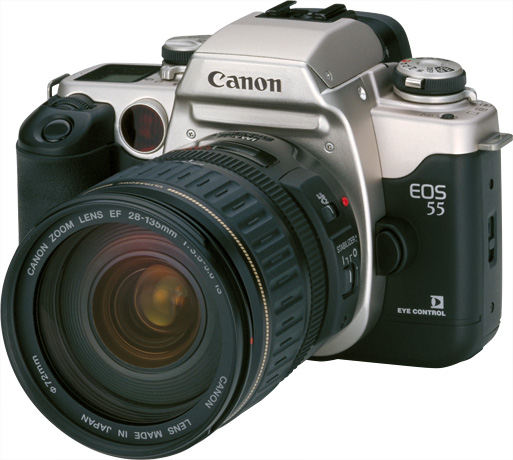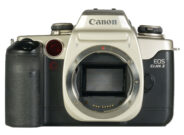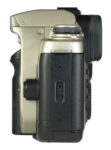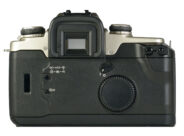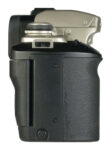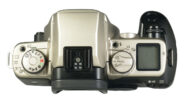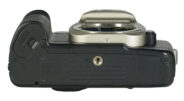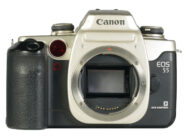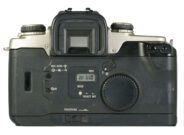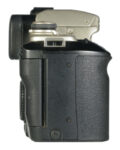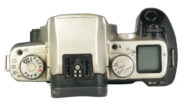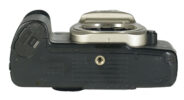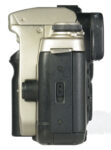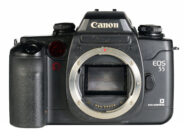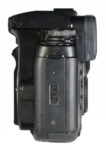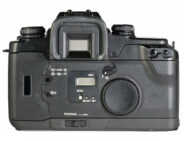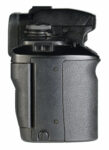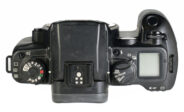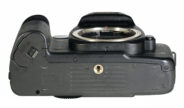Canon EOS ELAN II
aka Canon EOS 50
aka Canon EOS 50E
aka Canon EOS 55
aka Canon EOS ELAN IIE
35mm AF film SLR camera
Specification
| Production details: | |
| Announced: | September 1995 |
| System: | ● Canon EOS (1987) |
| Format: | |
| Maximum format: | 35mm full frame |
| Film type: | 135 cartridge-loaded film |
| Mount and Flange focal distance: | Canon EF [44mm] |
| Shutter: | |
| Type: | Focal-plane |
| Model: | Electronically controlled |
| Speeds: | 30 - 1/4000 + B |
| Exposure: | |
| Exposure metering: | Through-the-lens (TTL), open-aperture |
| Exposure modes: | Programmed Auto |
| Aperture-priority Auto | |
| Shutter-priority Auto | |
| Manual | |
| Physical characteristics: | |
| Weight: | 595g |
| Dimensions: | 153x105x71mm |
Manufacturer description #1
LAKE SUCCESS, N.Y., August 17, 1995 -- Canon U.S.A., Inc. is expanding its evolutionary camera design concept into a new generation EOS Elan. The Elan II, available in three versions, including an Eye-Control Autofocus model (Elan IIE) and Eye-Control Quartz Date model (Elan IIE QD), raises the standard of performance and technological excellence of photography with its new and improved camera features.
The improvements begin with the Elan II's new sturdy and attractive aluminum cover and simplified control layout for easy camera settings. Canon's exclusive AIM (Advanced Integrated Multi-Point Control) System links the camera's 3-point Autofocus to multi-zone metering for available light and flash, offering users sharp photographs regardless of where the main subject is within the picture frame. Metering can be set to 6-zone evaluative, 9.5 percent partial or center-weighted average for precise exposures and creative latitude in any shooting condition.
The Elan IIE features an improved version of Canon's exclusive Eye Controlled Focus technology. Focusing is faster, more precise and has the capability of functioning in the horizontal and vertical position. Additional features of the improved Eye Controlled Focus system include its direct link to the camera's Servo AF mode and Depth-of-Field indicator.
"The new EOS Elan II is designed with the same evolutionary concept that made the Canon EOS-1N overwhelmingly popular with professional and advanced amateur photographers worldwide," said Hank Maeda, vice president and general manager of Canon's Camera Division. "The new line of Elan cameras furthers Canon's commitment to combining form and function based on new and existing technology to better serve the needs of our customers," Mr. Maeda added. "The evolutionary changes incorporated into the Elan II bring the EOS System full circle as a truly integrated 35mm SLR system. Canon will continue to provide photographers with advanced imaging tools to help them realize their visions through photography."
The Elan II models also feature an improved Whisper Drive film transport system, improving the wind and rewind noise reduction. An exclusive belt transport system and other design improvements account for the noise reduction, enabling the camera to be used in shooting situations that require extreme quietness such as wildlife, theater and certain sporting events, such as golf.
Other new and advanced features of the EOS Elan II include:
- A choice of 10 exposure modes including manual exposure with scale-metering
- 11 Custom Functions including mirror lock and depth-of-field preview
- Exclusive E-TTL evaluative flash metering with optional Speedlite 380EX
Sophisticated Design
Distinctively styled after traditional SLR models, the EOS Elan II provides a look of sophistication while providing additional protection of camera components through its rugged, high-density aluminum coverplate. Also taken from traditional SLR designs, control dials and other key function dials are raised from the camera body for easier access and functionality.
The Command Dial, located to the left of the viewfinder, provides users with easy access to a wide range of exposure modes. The metering mode lever, located just beneath the Command Dial, permits photographers to choose from any of the three metering patterns. The camera's AF Mode Dial, allows users to choose from three autofocus modes including: One Shot AF, AI Servo, and AI Focus. The camera's Film Advance Mode lever, positioned below the AF Mode Dial, offers single-frame or continuous shooting at 2.5 frames per second. All critical information relating to exposure is displayed inside the viewfinder, allowing users to concentrate more on the subject and composition and less on the mechanics of photography.
Maintaining its user-friendly design, the Elan II's Main Dial is conveniently located behind the camera's shutter release button. Whether used alone or in conjunction with other system controls, the Main Dial's location provides users with quick selection of apertures, shutter speeds, and other camera functions, without the need to remove their eye from the viewfinder. The Quick Control Dial, located on the back of the camera and a design trademark of the Canon EOS System, provides users with additional control options carefully positioned for easier accessibility.
Evolutionary Process Includes Improved Eye Controlled Focus
The revolutionary concept of Eye Controlled Focus was originally incorporated into the EOS A2E. Since that time, Canon has made tremendous improvements in Eye Controlled Focus technology. In the EOS Elan IIE model, the improvement lies in the camera's ability to utilize Eye Controlled Focus in both the horizontal and vertical camera positions. The Eye Controlled Focus system is linked directly to the three focusing points, allowing users to simply look through the viewfinder at their subject. The camera acknowledges the main subject, regardless of its positioning within the frame. This allows photographers to compose and focus simultaneously, providing greater access to the decisive moment of peak action or expression.
Beyond the camera's ability to focus in the horizontal and vertical positions using Eye-Control, additional camera functions can now be controlled through the camera's Eye-Control feature. For instance, photographers can use the Eye-Control function to control the Depth-of-Field mode for regulating near and distant subjects rendered as sharp in the final image. Eye Controlled Focus works in harmony with the Canon AIM (Advanced Integrated Multi-Point) system to integrate focus, exposure, and flash for optimum results.
Calibrating the camera's Eye Controlled Focus is a simple process. Setting the camera's Command Dial to the calibration setting (CAL), the user simply looks at the flashing focusing point in the viewfinder while depressing the shutter button half way. Another focusing point will flash and the same procedure is followed. The Eye Controlled Focus functions of the camera are now calibrated to the user's eye. The Elan IIE is capable of storing Eye Controlled Focus calibration settings for up to three users.
The speed and accuracy of the Elan II's autofocus system is built around its multi-BASIS (Base Stored Image Sensor) system. Utilizing the camera's three-zone autofocus system, the BASIS system features a cross-type sensor at the center, coupled with vertical line sensors to the left and right, which enable the camera to anticipate changes in the subject's position.
The Canon Elan II offers users three autofocus modes for precise focus in any shooting situation -- One-Shot AF, AI Servo and AI Focus. In the One-Shot AF mode, users can focus on a subject by depressing the shutter button down half way to lock focus. As long as the shutter button remains depressed half way, focus will remain locked, allowing users to recompose the subject. In the AI Servo focus mode, users can track moving subjects as they move from one focusing point to another at a rate of 2.5 frames per second with the camera's built-in motor drive. In the AI Focus mode, the camera begins operation in the One-Shot AF mode, but will automatically shift to AI Servo for predictive autofocus if the main subject begins to move. Manual focus is available by moving a switch on the lens. Sharp focus can be confirmed by using the in-focus indicator in the viewfinder.
Exposure Control at Your Fingertips
The Elan II and IIE Command Dial, located to the left of the viewfinder, enables quick and easy access to several exposure modes from Programmed exposure to full manual control. The camera offers 10 exposure modes including a scale-metered mode when using manual exposure for precise metering.
In the Intelligent Program AE mode, the camera selects the proper shutter speed and aperture settings for a correct exposure based on lighting conditions, film speed, focal-length and maximum aperture of the lens being used.
The Shutter-Priority mode allows the user to pre-select the shutter speed while the camera designates the corresponding aperture for proper exposure. Photographers can choose any shutter-speed ranging from 30-seconds for time exposure to 1/4000 second for high speed action photography.
Photographers wishing to control depth-of-field can use the Aperture-Priority mode. The camera will automatically select the proper shutter speed based on the pre-selected aperture setting made by the photographer.
Manual exposure gives the photographer complete control over shutter speeds and apertures. The Elan II and IIE provide a metering scale in the viewfinder, permitting the photographer to better determine the effects of their creative techniques.
When using the Depth-of-Field AE mode, users can pre-determine precisely what areas of the frame will render sharp by simply selecting the nearest and farthest objects prior to exposure. This mode is especially beneficial for close-up and nature photography.
Programmed Image Control (PIC) Provides Complete Automation
Programmed Image Control (PIC) is designed to optimize aperture, metering, shutter speeds and other camera functions under some of the most common shooting situations encountered by photographers. Using Icons to identify common subjects, users can simply rotate the camera's Command Dial to the corresponding icon for the subject they are photographing.
In the Portrait PIC mode, the camera will favor a wide aperture to maintain focus on the main subject and blur distracting backgrounds. By using this mode with One-Shot AF, the user can focus on the subject and recompose the scene.
In the Landscape PIC mode, the camera favors a small aperture setting to assure that foreground and background subjects in the frame remain in sharp focus.
Close-Up PIC is ideal for flower and macro-type photography. In this mode, the camera controls depth-of-field to isolate the main subject from the background. Partial metering is used in this mode for precise exposure of the main subject.
Sports PIC is ideal for photographing fast-moving action such as a sporting event. In this mode, the camera will set a fast shutter speed to stop action. A wide aperture would also be used to isolate the main subject from the background.
In the Full Auto mode, also known as the "Green Zone" by the way it is identified on the Command Dial, provides the greatest level of automation and the maximum assurance of never missing a photo opportunity. In the Full Auto mode, the camera will set the optimum combination of shutter speed and aperture based on lighting conditions, film speed and the lens being used. If the subject is moving, the camera will automatically switch to AI Servo Focus to follow the subject anywhere within the picture frame. In low light conditions, the flash will automatically pop-up, providing additional light for a proper exposure.
Elan II and Elan IIE Offer Total Exposure Control
Bright backgrounds and backlit subjects can pose serious exposure problems for photographers if not metered properly. In many cases, a camera's metering system will take all the available light and average it together to give an overall acceptable exposure. In special instances, such as backlit subjects, this type of metering would render your main subject as a silhouette, or underexposed.
The EOS Elan and Elan IIE offer three built-in metering modes which provide properly exposed photographs under any lighting condition.
Six-Zone Evaluative Metering
Using the Elan II's Six-Zone Evaluative Metering system, photographers can be assured of proper exposure of the main subject, while rendering a "natural" exposure for the rest of the image. The three main zones of the six-zone system correspond directly to the camera's three-zone autofocus system, ensuring proper exposure of the main subject. The meter also weighs intermediate and peripheral metering zones and automatically compares them to the main subject. The result is a perfectly exposed photograph with emphasis on the main subject.
Partial Metering
Another improvement with the EOS Elan II is its ability to use Partial Metering (9.5%) in any of the three autofocus zones. Even if the main subject is off-center, the result is an ideal exposure. Partial metering is ideal for extremely bright and dark backgrounds and can be used with the camera's creative exposure modes including Intelligent Program, Shutter-Priority, Aperture-Priority, Depth-of-Field and Manual.
Centered-Weighted Average Metering
In the Center-Weighted Average Metering mode, the camera will view all the light available in a particular scene, placing emphasis on the camera's center zone. This mode is ideal for everyday shooting situations where the main subject is traditionally in the center of the frame.
Auto Exposure Lock
The Elan II and IIE's evaluative metering system is linked to the three focusing points in the viewfinder. Based on the focus point in use, it can control the exposure according to the subject's position in the frame. Exposure is automatically locked upon focus completion when using Intelligent Program, Shutter-Priority, Aperture-Priority, or Depth-of-Field modes in One-Shot AF. However, if the user wishes to lock exposure while in AI Servo AF or Manual focusing modes, the user must depress the AE Lock button located on the back of the camera. AE Lock is particularly effective when combined with Partial Metering for heavily backlit or small subjects.
Built-in Flash Offers Creative Opportunities
The EOS Elan II cameras offer a built-in retractable flash, providing TTL flash control. In the full-Auto, Portrait PIC, and Close-Up PIC modes, the flash will automatically pop-up and provide optimum exposure in low-light conditions. In Intelligent Program mode, the viewfinder will advise the user when flash is necessary for proper exposures. The flash provides a wide angle of coverage and may be used with focal lengths as wide as 28mm, making it ideal for use with standard zoom lenses.
The built-in flash features a red-eye reduction mode to minimize red-eye of subjects in low-lighting conditions. The flash features a guide number of 43/13 (ft./m) with ISO 100 film and a rapid recycle time of approximately two seconds.
The camera's built-in flash also offers creative functions such as Slow-Speed Synchronization for combining foreground subjects with a low light background. The camera's AIM system integrates low light exposure control, flash exposure control, and autofocus functions, for natural-looking photographs.
To create a dramatic combination of sharp subjects and "natural-looking" blurred movements, such as light streaks behind automobile tail-lights at night, Second-Curtain Sync fires the flash toward the end of the exposure. This makes light streaks appear behind moving subjects instead of around or in front of them.
New E-TTL Flash System Offers Tremendous Creative Latitude
Canon has taken TTL flash exposure systems one further step with its new E-TTL (Evaluative TTL) flash system. While conventional TTL and A-TTL flash systems measure and control flash illumination reflected from the film's surface during exposure, Canon's Speedlite 380EX provides even greater convenience and accuracy. The new features of the 380EX were designed for use exclusively with the EOS Elan II and IIE camera bodies.
With E-TTL, flash exposure is measured and controlled by the Elan II's six-zone evaluative metering sensor in combination with the AIM system. Ambient light levels, subject position in the frame and pre-flash data are instantly analyzed, providing a natural balance between subject and background. Working in conjunction with Canon's AIM system, E-TTL flash metering is linked to the active focusing points for precise exposure of the subject.
FE Lock and High-Speed Sync Exclusive Features To Elan II / IIE Cameras
FE Lock (Flash Exposure Lock) provides an AE Lock function for flash photography. Available exclusively with the combination of the EOS Elan II cameras and Speedlite 380EX, FE Lock takes advantage of the camera's AIM System and 9.5% Partial Metering capability to isolate flash readings to a small part of the picture area.
With FE Lock, the Speedlite 380EX pre-flash fires when the camera's AE lock button is depressed, storing AF and metering data for up to 16 seconds, providing enough time for composition or background exposure adjustments. FE Lock can be used in conjunction with Intelligent program, Shutter-Priority, Aperture-Priority, or Manual exposure modes.
When the optional Speedlite 380EX is set to the FP mode, the Elan II cameras can be synchronized with flash at speeds of up to 1/4000 second, the same high speed shutter range as with daylight photography.
All Canon Speedlites designed for use with the EOS System cameras are fully compatible with the Elan II cameras. The new Speedlite 380EX is compatible with all cameras in the EOS line but only offer E-TTL flash metering when used in conjunction with the EOS Elan II cameras.
Improvements Made to Quiet Whisper Drive Film Transport System
The original EOS Elan was the first EOS camera to incorporate comprehensive noise reduction measures for quiet, more pleasant shooting. The Elan II cameras maintain the same noise reducing Whisper Drive System. The new cameras offer users a choice of rewind modes: silent and high speed rewind. Selected through the Custom Functions features of the camera, the silent mode will rewind a 24-exposure roll of film in 12-seconds. In the high speed mode, the same roll of film will rewind in just 6-seconds.
Eleven Custom Functions Expand Creative Choices
Canon has incorporated eleven Custom Function features into the new EOS Elan II, allowing users to customize the camera to their specific photographic style and needs.
Elan II Camera Accessories
Several new accessories will be available with the new EOS Elan II cameras. The Battery Pack BP-50 enables the camera to be operated with four AA-size alkaline or NiCd batteries. These batteries are more easily obtainable than the standard 2CR5 battery. In addition to supplying power, the unit also provides an ON/OFF switch and an additional shutter-release button for vertical shooting.
The High-Capacity Battery Pack BP-5B is designed to be clipped on to a belt and provides extended power to the camera via four D-size batteries. It lasts approximately 8.5 times longer than the standard 2CR5 battery and is an ideal accessory when shooting in extreme weather conditions. The External Battery Pack BP-5B must be used in conjunction with the Battery Pack BP-50.
The Dioptric Adjustment Lens Ed can be interchanged with the standard EOS Elan II and IIE eyepiece The Ed series lenses are available in settings from +3 to -4 and are ideal for users who wear eyeglasses.
All EOS Elan II cameras can be used with optional remote controls including the wired Remote Switch RS-60E3 and wireless remote Controller RC-1.
The complete line of EOS /Elan II cameras will be available nationwide in early September.
Manufacturer description #2
Photography provides an endless variety of subjects, and every subject provides an endless variety of creative compositions. The EOS 50E makes it easy for you to concentrate on composition, rather than camera function.
The three-point Eye Controlled Focus system almost always puts a focusing mark where you want it... where you're looking! This intuitive interface joins you and the camera as never before. For creative images as never before. With its advanced Eye Controlled Focus, the EOS 50E literally becomes an extension of your vision. After you complete a simple calibration process to customise the system for your eyesight, the camera stores your personal data in one of three calibration channels. An intelligent program accumulates even more data when you add calibrations to your channel during various indoor and outdoor lighting conditions.
The Canon EOS 50EQD is identical to the EOS 50E but comes equipped with a QuartzDate back that allows you to print the date (Day, Month, Year/Month/Day, Year/Year, Month, Day) or the exact time in Hours and Minutes directly on the photo.
Manufacturer description #3
Following the EOS 5, this is the second AF SLR camera featuring Eye Controlled Focus. The EOS 55’s Eye Controlled Focus is twice as fast as the EOS 5’s. Also, the Eye Control BASIS AF sensor enables Eye Controlled Focus even during vertical shooting. The new AF sensor also enables focus tracking with your eye while you press the shutter button halfway or during continuous shooting. The camera controls include a Command Dial (well received on other EOS cameras), LCD panel, a new AF mode dial on the camera’s right shoulder, a metering mode lever, and a film advance mode lever. This two-dial and two-lever system makes camera operation quick and easy. The exterior finish incorporates high-quality aluminum.
Table of contents
Clickable
Instruction manual
Clickable
Canon EOS system cameras
Clickable
- Canon EF-M
- Canon EOS 10 S
- Canon EOS 10D
- Canon EOS 1D
- Canon EOS 1D mark II
- Canon EOS 1D mark II N
- Canon EOS 1D mark III
- Canon EOS 1D mark IV
- Canon EOS 1D X
- Canon EOS 1D X Mark II
- Canon EOS 1D X Mark III
- Canon EOS 1Ds
- Canon EOS 1Ds mark II
- Canon EOS 1Ds mark III
- Canon EOS 3
- Canon EOS 3000
- Canon EOS 5000
- Canon EOS 5D
- Canon EOS 5D mark II
- Canon EOS 5D mark III
- Canon EOS 5D mark IV
- Canon EOS 5Ds
- Canon EOS 5Ds R
- Canon EOS 620
- Canon EOS 630
- Canon EOS 650
- Canon EOS 6D
- Canon EOS 6D Mark II
- Canon EOS 700
- Canon EOS 750 QD
- Canon EOS 850
- Canon EOS A2
- Canon EOS D30
- Canon EOS D60
- Canon EOS ELAN
- Canon EOS ELAN 7E
- Canon EOS ELAN 7NE
- Canon EOS ELAN II
- Canon EOS IX
- Canon EOS IX Lite
- Canon EOS Rebel 2000
- Canon EOS Rebel G
- Canon EOS Rebel K2
- Canon EOS Rebel S II QD
- Canon EOS Rebel T2
- Canon EOS Rebel Ti
- Canon EOS Rebel X
- Canon EOS Rebel XS
- Canon EOS Rebel XS N DATE
- Canon EOS RT
- Canon EOS-1
- Canon EOS-1N
- Canon EOS-1N RS
- Canon EOS-1V
